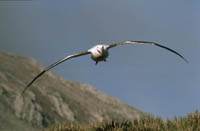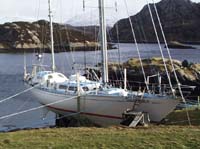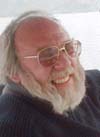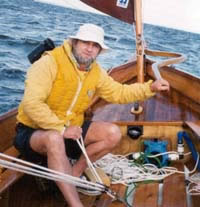Communications on English Rose VI
Created | Updated May 7, 2006
John Ridgway Save the Albatross Voyage 2003-4
AIM: TO PREVENT THE NEEDLESS SLAUGHTER OF THE ALBATROSS

by Nick Grainger
A key component of the Save the Albatross Voyage will be the ability to communicate with interested people around the world and to promote global discussion and action to prevent the needless slaughter of the albatross. We plan to do this during the voyage primarily through the Internet.
We plan to:
- Participate in live voice conferences on the Internet using the BBC 'Live Studio' facility
- Shoot video on the boat and stopover points. Clips from these recordings will subsequently be available on the Internet via the BBC website
- Take still pictures and distribute them via the Internet,
- Participate in online text discussion,
- Regularly update our pages, ship's position and log on the BBC H2G2 website,
- Continually gather material for the two BBC films.
We hope to engage the interest of diverse groups of people: school classes, environmentalists, and the general public. We seek to influence legislation to enforce alteration to long-line fishing boats to the degree where albatrosses are no longer caught.
To record video and sound and communicate with diverse audiences via the Internet on a regular basis from a yacht circumnavigating the world in the Southern Ocean will be challenging. All the hardware for instance, must be protected against seawater, fit within the limited space available, and consume the least amount of power possible.

Communication hardware and processes:
It is proposed that video images and sound aboard the yacht will be captured by fixed cameras, a hand held digital camera and a minidisk sound recorder with the assistance and support of Aerial Camera Systems.
The video material will be initially edited aboard the yacht using an IBM R40 laptop sealed in a custombuilt aluminium waterproof box. This will be attached to a flat screen located inside a custombuilt aluminium box on the bulkhead of the Communications area and a waterproof keyboard and Mouse on the Comms. area desk. The laptop will be powered from the yacht's 24v DC batteries.
The basically edited video material will be stored on mini dv tapes, and sent to the BBC from each stopover point. Cost benefit studies into the use of a F77 high bandwidth satellite link to enable the transmission of video directly from the yacht indicated the benefit was not worth the considerable cost.
A voice and data link will probably be maintained with an Iridium 9505 satellite phone. This gives a much slower link but is expected nevertheless to meet the communication needs of the voyage.
Still pictures will be taken using a splash proofed digital camera. (Nikon 5700) The pictures will be processed using Photoshop and saved to CD for passing to the BBC at stop over points. Small versions of key pictures will be uploaded to the H2G2 web-site via the Iridium link.
Regular open conference calls, supported by recent photos, will be held using the BBC Live Studio facility in London. People throughout the world will be able to hear and see these live presentations by visiting the appropriate URL on the Internet. They will be able to ask questions of the yacht crew, in real time, by emailing or phoning the BBC Live Studio. The latter will select representative questions that will then be sent to the yacht via the Iridium phone. Both questions and answers will be heard by all those visiting the web-site and will be recorded for replay on demand by visitors to the site.
Finally the link to the Internet will be used to maintain a log on the BBC H2G2 web-site as already outlined, update an online mapping system and to participate in ongoing discussion on that site.
An online mapping system has been developed with Communication::Design in Melbourne. This is planned to show the daily position of the yacht and also the daily flight plots of albatrosses carrying satellite tags, courtesy of the British Antarctic Survey.
Whilst the yacht will commonly sail between 150 and 250 kilometers in a day, past records indicate we can expect the tagged alabrosses to fly up to 2,600 kilometers in a day! It'll be quite a show.
Resources required to support the above:
Onboard digital video cameras and sound recording:
Satellite Link
Laptop Computer
 The laptop and peripherals are kindly being set up and tested by Mr Tony Tizzard in Greenock, Scotland.
The laptop and peripherals are kindly being set up and tested by Mr Tony Tizzard in Greenock, Scotland.
 Custombuilt watertight aluminium box with special cooling facility to contain laptop, external hard drive, floppy drive, USB hub and power converters. This enclosure for laptop and peripherals and the remote screen, (below) are kindly being designed and built by Nev Roberts in Eddington, near Bendigo, Victoria, Australia.
Custombuilt watertight aluminium box with special cooling facility to contain laptop, external hard drive, floppy drive, USB hub and power converters. This enclosure for laptop and peripherals and the remote screen, (below) are kindly being designed and built by Nev Roberts in Eddington, near Bendigo, Victoria, Australia.Nick Grainger,
Melbourne,
March 2003
Back to the Contents page
